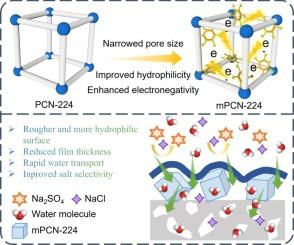Boosted performance of thin-film nanocomposite membranes based on phytic acid functionalized Zr-MOF for nanofiltration
IF 8.3
1区 工程技术
Q1 ENGINEERING, CHEMICAL
引用次数: 0
Abstract
Endowed with designable pore structure and intrinsically interconnected channels, metal-organic frameworks (MOFs) offer immense potential as functional nanofillers to boost the performance of nanocomposite membranes. However, achieving optimal pore size matching between MOFs and the polymer matrix while maintaining robust interfacial affinity remains a significant challenge in fabricating high-performance nanocomposite membranes. Herein, natural organic polyphosphate phytic acid was utilized to functionalize PCN-224 to narrow its pore size and enhance the polymer affinity. Thin-film nanocomposites containing mPCN-224 were afterward synthesized on the polysulfone support through a combined approach of anodic electrophoretic deposition (EPD) and vacuum filtration-assisted interfacial polymerization (VF-IP). The incorporation of mPCN-224 nanoparticles not only enhanced the hydrophilicity and electronegativity of the polyamide film but also led to a substantial reduction in film thickness. This is likely attributed to lessened piperazine supply at the interface, related to its limited diffusion at the presence of negatively charged mPCN-224. The additional nanochannels provided by mPCN-224, coupled with the loose PA layer, resulted in a substantial 56.3 % increase in the water permeance of the TFN-mPCN-224 membrane, reaching 20.0 L m−2 h−1 bar−1. Additionally, the post-synthesis modification with phytic acid led to an improved Cl−/SO42− selectivity coefficient of 44, substantially higher than that of the TFN-PCN-224 membrane. This improvement was primarily attributed to the narrowed pore size of mPCN-224 and the enhanced surface electronegativity. This study introduces a pathway for developing high-performance TFN membranes based on post-synthetic modification of MOF nanofillers with phytic acid molecules.

基于植酸功能化 Zr-MOF 的薄膜纳米复合膜在纳滤中的性能提升
金属有机框架(MOFs)具有可设计的孔隙结构和内在互连通道,作为功能性纳米填料在提高纳米复合膜性能方面具有巨大潜力。然而,在制造高性能纳米复合膜的过程中,如何实现 MOFs 与聚合物基质之间的最佳孔径匹配,同时保持稳定的界面亲和力,仍然是一项重大挑战。在此,我们利用天然有机聚磷酸盐植酸对 PCN-224 进行功能化,以缩小其孔径并增强聚合物亲和力。随后,通过阳极电泳沉积(EPD)和真空过滤辅助界面聚合(VF-IP)相结合的方法,在聚砜载体上合成了含有 mPCN-224 的薄膜纳米复合材料。mPCN-224 纳米粒子的加入不仅增强了聚酰胺薄膜的亲水性和电负性,还大大降低了薄膜厚度。这可能是由于哌嗪在带负电荷的 mPCN-224 存在时扩散受限,从而减少了界面处的哌嗪供应量。mPCN-224 提供的额外纳米通道加上松散的 PA 层,使 TFN-mPCN-224 膜的透水性大幅提高了 56.3%,达到 20.0 L m-2 h-1 bar-1。此外,用植酸进行合成后改性后,Cl-/SO42- 选择性系数提高到 44,大大高于 TFN-PCN-224 膜。这一改进主要归功于 mPCN-224 的孔径变窄和表面电负性增强。本研究介绍了一种基于植酸分子对 MOF 纳米填料进行后合成修饰的高性能 TFN 膜的开发途径。
本文章由计算机程序翻译,如有差异,请以英文原文为准。
求助全文
约1分钟内获得全文
求助全文
来源期刊

Desalination
工程技术-工程:化工
CiteScore
14.60
自引率
20.20%
发文量
619
审稿时长
41 days
期刊介绍:
Desalination is a scholarly journal that focuses on the field of desalination materials, processes, and associated technologies. It encompasses a wide range of disciplines and aims to publish exceptional papers in this area.
The journal invites submissions that explicitly revolve around water desalting and its applications to various sources such as seawater, groundwater, and wastewater. It particularly encourages research on diverse desalination methods including thermal, membrane, sorption, and hybrid processes.
By providing a platform for innovative studies, Desalination aims to advance the understanding and development of desalination technologies, promoting sustainable solutions for water scarcity challenges.
 求助内容:
求助内容: 应助结果提醒方式:
应助结果提醒方式:


